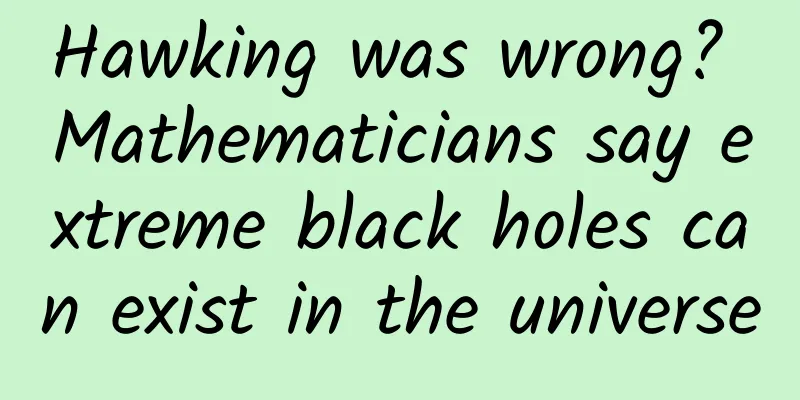Hawking was wrong? Mathematicians say extreme black holes can exist in the universe

|
Theoretical physicist Stephen Hawking and others created a branch of physics called black hole thermodynamics by analogy with the laws of thermodynamics. They firmly believed that the unproven third law of black hole thermodynamics must hold true, just as it does in thermodynamics, or there would be a risk of releasing a naked singularity. But now, two mathematicians have proved Hawking wrong. In two recent papers, Christopher Keller of MIT and Ryan Unger of Stanford University pointed out that the third law is dead. Written by | Jiawei Einstein was wrong when he said “God does not play dice.” Analysis of black holes suggests that not only does God indeed play dice, but he sometimes confuses us by throwing the dice where we cannot see them. —Stephen Hawking The "place we can't see" that Stephen William Hawking, a theoretical physicist who died on March 14, 2018, refers to is within the event horizon of a black hole. Although Hawking himself learned the lesson of Einstein's excessive pursuit of idealism and was sufficiently wary of the irrationality of black holes, in the end, Hawking was wrong. He insisted that there was nothing in the laws of physics we know to prevent the formation of celestial bodies that are absolutely impossible in theory, according to a recent brilliant paper by two mathematicians. Black holes are the most extreme objects in the universe. Inside them, spacetime is so curved that, according to Einstein's theory of general relativity, nothing can escape once it crosses the event horizon of a black hole. For charged or rotating black holes, the forms of black holes are even more diverse. One of the most interesting cases is the extreme black hole . The famous No Hair Theorem is an important theory about the properties of black holes. According to this theorem, the final state of a black hole is determined by only three physical quantities: mass, angular momentum, and charge. This means that, apart from these three quantities, a black hole does not retain any other information (hair). A black hole formed by 10 billion tons of ice cream and a static black hole formed by 10 billion tons of gold are essentially no different. Based solely on the physical properties of these two black holes, we cannot distinguish them and determine which one is ice cream and which one is gold. The first black hole photo in human history. It shows the image of the supermassive black hole M87* in the M87 galaxy at the center of the Virgo galaxy cluster. The multinational Event Horizon Telescope (EHT) project team released it on April 10, 2019. However, there are indeed differences between black holes. When the mass is constant, if the charge or angular momentum of a black hole reaches a certain limit, we call it an extreme black hole. Because black holes themselves are extreme celestial bodies, extreme black holes can also be understood as the extreme of extremes. On the other hand, black holes can also be charged, and charged spinless black holes (Reissner-Nordström black holes, abbreviated as RN black holes) are different from ordinary black holes. They have two horizons. When an object passes through the outer horizon, it will be sucked to the inner horizon by the strong gravity. At the inner horizon, due to the huge reaction of the energy blueshift effect on space-time, the inner horizon will become the location of a new singularity. Since the electromagnetic repulsion when compressing charged mass is much greater than gravity (about 40 orders of magnitude greater), it is expected that black holes with large charges will not form in nature. At the same time, if the charge of a charged black hole is too large, a so-called extreme RN black hole will appear. If any small amount of charge is added to it, the black hole's event horizon will disappear, leaving a naked singularity. Physicists speculate that nature prohibits the formation of such naked singularities. Extreme black holes also have many strange properties. The most special one is that the surface gravity at the event horizon of this black hole is zero, and its temperature is also zero, which means that the extreme black hole is a system at absolute zero. In 1973, renowned physicists Stephen Hawking, James M. Bardeen, and Brandon Carter asserted that extreme black holes could not exist in the real world—they simply could not form. Yet, over the past 50 years, extreme black holes have been very useful models in theoretical physics because they have nice symmetries that make calculations easier. Why do Hawking and others reject extreme black holes? The reason starts with the second law of thermodynamics... If someone points out that your favorite theory of the universe doesn't agree with Maxwell's equations, then Maxwell's equations are in big trouble. If it contradicts experimental observations, then these experimentalists do sometimes screw up. But if your theory violates the second law of thermodynamics, then I can't make it up for you. It has no way out except to collapse in the deepest humiliation. —Arthur Stanley Eddington The second law of thermodynamics is a rule that describes the transformation of heat and energy in nature. It tells us that heat always flows spontaneously from a hotter object to a cooler object until equilibrium is reached. During this process, some of the heat becomes unusable energy, which reduces the efficiency of the system. This is why we can't build a perpetual motion machine or wait for a cup of coffee to automatically return to the temperature when it was first brewed. Entropy is a physical quantity used to measure the degree of disorder in a system. The higher the entropy, the more chaotic the system is and the more unpredictable it is. For example, a pile of playing cards has a low entropy if they are arranged in order, because we know where each card is; if they are shuffled, the entropy is high because we don't know where each card is. The second law of thermodynamics can also be expressed in terms of entropy: in a closed system, entropy will never decrease, it will only increase or remain the same. This means that any process in nature will lead to an increase in the disorder of the system. Eddington's famous quote dates back to 1927, and although the second law of thermodynamics was sacrosanct then and now, it experienced a crisis in the 1970s. But this begs the question: According to the sacred second law, the thermodynamic entropy of the universe as a whole does not decrease. But we can throw some garbage, such as broken glass or burnt letters, which have extremely high uncertainty (entropy) and we cannot recover the information in them, into a black hole. In this way, the entropy of the part of the universe outside the black hole decreases. On the other hand, black holes are essentially very simple, just like electrons. According to the black hole no-hair theorem, black holes do not have the property of entropy, so we actually reduce the entropy of the entire universe and violate the sacred second law of thermodynamics. The above thought experiment originated from the insightful physics thinker John Archibald Wheeler. However, at that time, the entire physics community had been baptized by relativity and quantum mechanics, and was somewhat numb to this kind of thought experiment that impacted the existing system. Oh, didn’t the theory of relativity break the absolute view of space and time? Didn’t quantum mechanics overturn the certainty of physical reality? Now it’s the turn of the second law of thermodynamics? Well, if the second law is not universally applicable within the universe, it doesn’t seem unacceptable. But one of Wheeler's students wasn't buying it. Jacob Bekenstein firmly believed that black holes should not violate the second law. He believed that the entropy consumed by black holes should become part of the black hole. Bekenstein used an analogy in mathematical expressions to argue that the entropy of a black hole should be reflected in the area of its event horizon. However, cosmologists including Hawking were skeptical at the time. This is because according to Bekenstein's theory, although nothing can escape from a black hole, the black hole itself has temperature, and temperature means thermal radiation. Hawking initially thought that Bekenstein's use of mathematics was too crude, and that he compared things that should not be put together. But in the process of his own deduction, Hawking began to recognize Bekenstein's logic. In particular, Hawking realized that his own famous law—that the surface area of a black hole’s event horizon does not decrease—was in perfect harmony with Bekenstein’s theory: 1. The second law of thermodynamics states that the entropy of an isolated system does not decrease. 2. Hawking discovered that the surface area of a black hole’s event horizon does not decrease. 3. Bekenstein said that the event horizon of a black hole is proportional to the entropy of the black hole. At the same time, Hawking and other physicists further realized that the equations describing the evolution of black holes are very similar to the equations of thermodynamics. Therefore, Bekenstein can draw an analogy between entropy and the horizon of a black hole, and even continue the analogy. James Bardeen, Jacob Bekenstein, Brandon Carter, and Hawking developed black hole thermodynamics in the early 1970s. These laws correspond one-to-one with the laws of thermodynamics in terms of mass and energy, area and entropy, and surface gravity and temperature. like The zeroth law of thermodynamics: In thermal equilibrium, the temperature of a system is the same everywhere. The zeroth law of black hole thermodynamics: A stationary black hole has the same surface gravity over the entire event horizon. Similarly, there are the first and second laws. The second law is the analogy between the area of the black hole horizon and the thermodynamic entropy mentioned above. But to fully convert the two sets of equations, it is also necessary to replace the surface gravity at the black hole's event horizon with temperature. In 1974, Hawking showed that quantum field theory implies that black holes should radiate like black bodies, with a temperature proportional to the gravity at the surface of the black hole's event horizon, predicting the effect now known as Hawking radiation. Six years ago, Hawking's ashes were buried between Darwin and Newton's tombs in Westminster Abbey. The temperature formula of Hawking's radiation is engraved on the tombstone. | Source: Stephen Hawking - Wikipedia However, up to this point, a black hole should also have a property that corresponds to the third law of thermodynamics. The third law of thermodynamics states that it is impossible to reach absolute zero through any physical process. Correspondingly, the third law of black hole thermodynamics states that the surface gravity of a black hole cannot be reduced to zero in a finite time - because the surface gravity of a black hole is equivalent to the temperature of the black hole, and since the temperature cannot reach absolute zero, the surface gravity will not be zero. And as mentioned earlier, only extreme black holes have zero surface gravity. So the third law is equivalent to saying that there is no way to create an extreme black hole. Hawking and others were unable to prove this, but due to the consistency and completeness of the theory, they firmly believed it was true. One reason is also mentioned before. If a little more charge is added to the extreme RN black hole, the black hole's event horizon will be broken, and the singularity inside the black hole will be exposed to the world, which means a naked singularity is created. However, all physical laws will fail at a naked singularity. To exaggerate, a naked singularity will cause all knowledge, logic, theory and laws to collapse... It is something that should never appear in physics! Singularities must be sealed by the event horizon to prevent them from running into the real world. In addition, based on the analogy with thermodynamics, the gravity of a black hole at the event horizon is equivalent to the temperature of the black hole. The absence of gravity means that the temperature of the black hole event horizon is zero, and the black hole will stop radiating heat to the outside. However, this contradicts the famous Hawking radiation phenomenon. Therefore, Hawking believes that the existing laws of physics must imply the fact that "the surface gravity of a black hole cannot be reduced to zero in a finite time", otherwise there is a risk of releasing a naked singularity. The laws of nature cannot be so sloppy. But now, two mathematicians have proved Hawking and his colleagues wrong. In two recent papers, Christoph Kehle of MIT and Ryan Unger of Stanford University show that there is nothing in the laws of physics that we know of that prevents extreme black holes from forming. The Third Law is dead. —Ryan Unger Keller and Unger did not set out to search for extreme black holes; they were studying the formation of charged black holes. "We suddenly realized that we could do it - theoretically create a black hole - even with an extremely large charge-to-mass ratio. And that's the hallmark of an extreme black hole," Keller recalled. They started with a non-spinning, uncharged black hole and simulated what might happen if they placed it in a simplified environment called a scalar field, which assumes a background of uniformly charged particles. They then zapped the black hole with pulses from the field to increase its charge. These pulses also provide electromagnetic energy to the black hole, which, according to the mass-energy equation, is equivalent to increasing the black hole's mass. By sending diffuse, low-frequency pulses, the two mathematicians realized that they could make the charge increase faster than its mass at a corresponding rate - exactly what they needed for their proof. Ryan Unger and Christopher Keller. Their mathematical proof is “beautiful, technically innovative, and physically surprising,” said Mihalis Dafermos, a mathematician at Princeton University, who added that it hints at a potentially richer, more diverse universe in which “extreme black holes can astrophysically exist.” But that doesn't mean they really exist. Just because there is a mathematical solution with nice properties doesn't necessarily mean nature will take advantage of it. All we know for sure is that we can't deduce from the existing laws of physics that extreme black holes exist. They can exist mathematically, but there's no guarantee that they do. Extreme black holes require black holes to have maximum electric charge. But so far, we have no conclusive observational evidence for general charged black holes. Some readers may remember that at the beginning of the article, in addition to charged black holes, rotating black holes can also form extreme black holes. So is it easier to form extreme black holes from rotating black holes? Having shown that highly charged extreme black holes are mathematically possible, Ryan Unger of Stanford University is now trying to show that rotating extreme black holes are also possible. But this is a much more difficult task. But there is good news. Keller and Unger found that the formation of an extreme black hole does not open the door to a naked singularity, as physicists feared. Instead, extreme black holes seem to be at a critical threshold: add just the right amount of charge to a dense cloud of charged matter, and it collapses to form an extreme black hole. If a little more charge had been added, the cloud would not have collapsed into a naked singularity, but would have simply dispersed without forming a black hole. The two were very excited about this result, which is no less than the existence of extreme black holes. “This is a beautiful example of mathematics giving back to physics,” said Elena Giorgi, a mathematician at Columbia University. Acknowledgements: Thanks to Associate Researcher An Yusen from Nanjing University of Aeronautics and Astronautics Special Tips 1. Go to the "Featured Column" at the bottom of the menu of the "Fanpu" WeChat public account to read a series of popular science articles on different topics. 2. Fanpu provides a function to search articles by month. Follow the official account and reply with the four-digit year + month, such as "1903", to get the article index for March 2019, and so on. Copyright statement: Personal forwarding is welcome. Any form of media or organization is not allowed to reprint or excerpt without authorization. For reprint authorization, please contact the backstage of the "Fanpu" WeChat public account. |
<<: National Disability Prevention Day | Everyone needs to know about disability!
>>: Tengchong volcano actually looks like Yunnan's "mushrooms"? And they are in pairs!
Recommend
Huawei Developer Competition offline sharing session @ Huawei Connect Conference
On August 31, 2016, HUAWEI CONNECT 2016 was grand...
How to use data operation methods to improve article conversion rate
Nowadays, many products need to be sold on offici...
The seemingly alien "vampire" is actually a "living fossil" on Earth that existed much earlier than the dinosaurs
Lampreys are one of the oldest vertebrates on Ear...
Can Lei Jun’s dream of creating a Chinese Sony come true?
What is Lei Jun's dream for Xiaomi? At Xiaomi...
Does the Mini Program need to have a store nearby? Does the Mini Program have to have a physical store?
Q: Does the Nearby Mini Program need to have a st...
How much does it cost to be an agent for a fruit mini program in Dali?
How much does it cost to be an agent of Dali Frui...
How does Pinduoduo deeply tap into the number of WeChat users?
Pinduoduo pays more attention to the understandin...
A brief discussion on automobile brand marketing!
This article talks about my views on automobile m...
How much does it cost to attract investment for Benxi Home Furnishing Mini Program?
How much does it cost to attract investment for t...
Is alcohol a screen killer? Countless mobile phones have been killed!
Review expert: Zhu Guangsi, member of Beijing Sci...
Can you make a ball float in the air by just shouting? It's not magic, it's the power of sound
No one touches the ball, but it stays in the air....
Play with Zhihu, all the Zhihu operation skills you don’t know are here
Growth is a hot topic . Who doesn’t want targeted...
The data logic behind the year-end growth of APP
The global app economy is in a period of rapid gr...
iOS 16.2 finally supports 120Hz high refresh rate!
The day before yesterday, Apple pushed the iOS 1...
Analysis of Mobike and ofo bike competition
1. Introduction Test models: Xiaomi MAX, iPhone 6...









